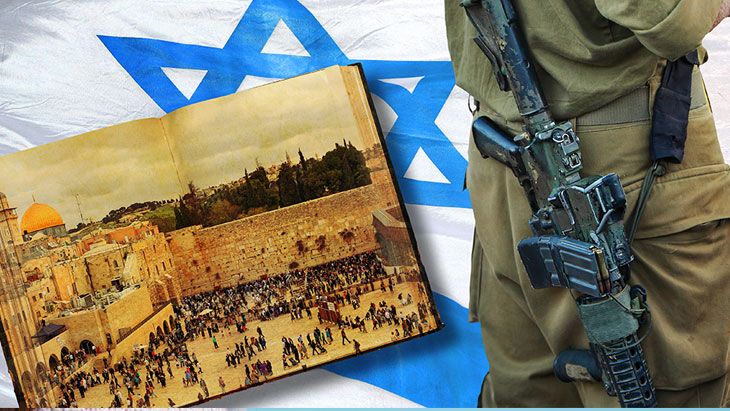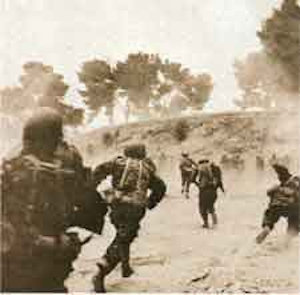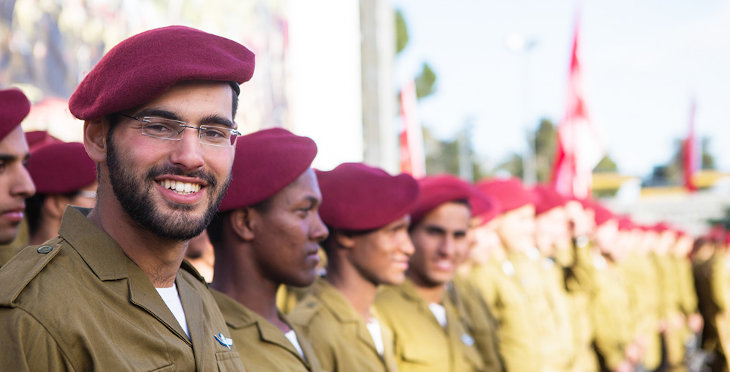 Raise a Glass to Freedom
Raise a Glass to Freedom


10 min read
The decisive battle paved the way for Israel to reunify Jerusalem in 1967.
The weeks before Shavuot in 1967 were incredibly tense for the Jewish people. Israel’s Arab neighbors were threatening war, and some violent clashes had even broken out along Israel’s borders.
Jerusalem was divided: Jordanian troops controlled much of the eastern and northern part of the city, including the Old City and the Western Wall. Since 1948 when the Old City fell to Jordan’s army, no Jews had been allowed to live or even set foot in the Arab-controlled precincts of the city. The only exception was Mount Scopus, in the northern part of Jerusalem.
Visitors to Israel’s capital today know Mount Scopus as the bustling home of Hebrew University and Hadassah Hospital. From 1948 to 1967, the university and hospital operated out of buildings in the western part of Jerusalem, and Mount Scopus was a besieged holdout under Israeli control, surrounded by hostile Jordanian troops.
In those tense days, Rabbi Shlomo Goren, chief rabbi of the Israeli Defense Force (IDF), recalled sensing that war was on the horizon. He made a long-anticipated trip to Australia, but then decided to cut it short and return to Israel.
 Soldiers of the 55th Paratrooper Brigade pause from training for a photo at Beit Guvrin in 1965 (photo credit: COURTESY DAN SHILOAH ARCHIVE)
Soldiers of the 55th Paratrooper Brigade pause from training for a photo at Beit Guvrin in 1965 (photo credit: COURTESY DAN SHILOAH ARCHIVE)
“When our hosts learned that we were leaving,” he described, “a huge farewell event was arranged… Members of the Jewish community in Australia knew that I was on my way back to a war situation, and no one knew what the outcome would be… I remember saying at that gathering – with complete confidence – that with God’s help, I would merit to pray at the Kotel (Western Wall), something that I had been prevented from doing for nineteen years.” (Quoted in With Might and Strength: An Autobiography by Rabbi Shlomo Goren, Edited by Avi Rath, Maggid: 2016.)
Rabbi Goren’s words would prove prophetic. Within days, he was indeed praying at the Western Wall, first in the heat of battle, and then in peacetime in a united Jerusalem. This miraculous situation couldn’t have come about without one of the most decisive battles in the coming war: The Battle of Ammunition Hill, in Jerusalem’s north, which allowed Israeli troops to breach Jordanian lines and reunify Jerusalem at long last.
Ammunition Hill has been called one of the bravest battles in IDF history. Without it, Jerusalem would have remained in hostile Jordanian hands.
Called Giv’at HaTachmoshet in Hebrew, Ammunition Hill lies in northern Jerusalem, close to Mount Scopus. British troops built an arms storage unit in the area, and in 1948 Jordan captured the area and began turning the hill – as well as another hilltop nearby – into a heavily fortified military position.
Over the course of 19 years, Jordanian troops built a network of heavily fortified trenches that crisscrossed the hill. With its commanding height and seemingly impregnable defenses, Ammunition Hill ensured that Mount Scopus remained cut off from the rest of Israeli-held Jerusalem. Any move by the IDF to reunify the city meant that they would have to take Ammunition Hill, a seemingly impossible task.
 Trenches at Ammunition Hill
Trenches at Ammunition Hill
When Israel launched a pre-emptive attack on Egypt’s military airfield June 5, Jordanian troops began fighting Israel too. Israeli troops moved to Ammunition Hill to try and take this key outpost. IDF Col. Mordechai Gur was given the daunting task of conquering Ammunition Hill, one of the toughest assignments in the war.
Located in the heart of residential Jerusalem, it was deemed too risky to bomb Ammunition Hill from the air. Instead, about 150 Israeli paratroopers prepared to fight on the ground.
Artist and journalist Meir Ronnen was part of the initial troops sent to the Hill early on June 5. He later recalled he and his fellow soldiers found themselves preparing for war in the very heart of residential Jerusalem, surrounded by civilians.
We were “taken in Egged (Jerusalem’s municipal bus company) buses to Sanhedria (a neighborhood in Jerusalem), where elderly women in the Pagi apartment complex brought us buckets of tea and cakes,” Ronnen recounted. “Just after 10 AM, shlepping kit, personal weapons and the heavy Brownings (guns) and their tripods, we doubled through the Sanhedria cemetery...and debouched into a woefully shallow trench at the foot of Ammunition Hill.”
Tragically, Israeli military intelligence had underestimated the number of Jordanian soldiers defending Ammunition Hill. In those early, confused hours of the war, Ronnen’s troops found themselves unprepared.
“There were no officers with us… The trench position was dismal. I ordered the first platoon to drop everything and drag some nearby planks to cover the trench, as protection against mortar shells. We were to relieve a small unit of young reservists...but before they could leave the Jordanians suddenly opened fire… The Jordanians on Ammunition Hill promptly put a recoilless cannon shell into the top of the blockhouse. One of the young reservists, a corporal manning the observation post, lost his shoulder. We carried him out and along the trench under heavy machine gun fire…”

That night, 150 Israeli paratroopers moved into the area to attack Ammunition Hill. The IDF had faulty intelligence about the number of Jordanian soldiers guarding the post. Instead of attacking Ammunition Hill with a superior force, Israeli paratroopers entered the battle about evenly matched with Jordanian forces. Over the course of the brutal fighting overnight, most of the Israeli soldiers were either killed or wounded.
When the sun dawned on the morning of June 6, 1967, 36 Israeli soldiers had died in the fighting and about 90 were wounded. Most of the officers were among the dead.
The fighting was horrendous. Arriving on Ammunition Hill, IDF forces were forced to walk through the Jordanians’ heavily fortified, narrow trenches. Soldiers had to go single file; the narrow width meant that providing fire cover for those in front was virtually impossible. At first officers led the soldiers; they were cut down by Jordanian bullets and again and again, it was the lower ranking infantrymen who took over, leading the men onward.
Later on, the Battle for Ammunition Hill was dubbed the “Privates’ Battle,” for the brave way that lower ranking soldiers took over the fighting as their commanders were killed or wounded.
Another deadly hazard was the twisting nature of the Jordanian trenches. As the paths turned, every hundred yards or so, a Jordanian bunker housed enemy soldiers who targeted the advancing Israelis. The Israeli troops were sitting targets. Above the trenches, bullets and grenades whizzed by, coming from another Jordanian outpost nearby.
“I was really scared,” explained former Private Jacob Haimovitch. “It all happened so quickly.” When his platoon’s commander was hit by enemy fire, Pvt. Haimovitch took over, leading his comrades in their continued nighttime assault through the trench. “Although I was a simple soldier, I knew we couldn’t lose the momentum of the battle. My friends told me afterwards that I actually shouted ‘Aharai!’ (Follow me!) and then shot two bullets in the air.”
With Pvt. Haimovitch in the lead, his platoon managed to blow up the largest Jordanian bunker and take final control of Ammunition Hill.
Another hero of the Battle of Ammunition Hill was Private Eitan Neveh. With his platoon under heavy fire and grenades being lobbed into the trench he and his fellow soldiers were advancing through, Pvt. Neveh was ordered to leave the trench and provide cover fire for his fellow soldiers. With intense shooting taking place above the trench as well, Pvt. Neveh must have instantly realized this was a suicide mission, yet he didn’t hesitate.
He leapt out of the trench and was hit by several bullets as he provided fire cover for the IDF troops still in the trench. Just as he turned to return to the trench, he was hit in the head by a bullet; his lifeless body fell back into the trench. Another soldier quickly got out and took Pvt. Neveh’s place, providing fire cover.
After the battle, Pvt. Neveh was posthumously awarded the Itur HaGevurah, the Medal of Valor, Israel’s highest military honor. When his mother was asked what she found most noteworthy about her son’s award, she pointed to the word Turah (Private), her son’s low-level military rank. It wasn’t an officer or a famous general who displayed such heroism and gave his life to save his fellow soldiers; it was her son, Private Neveh, an ordinary soldier who displayed such incredible heroism and bravery.
Yossi Sidknoni was a paratrooper who took part in the battle. When his commander was shot in the chest by a Jordanian soldier, Sidkoni took his place. “Within seconds they began shooting at us,” he recalled of the battle. “We entered an area that was later named the ‘Triangle of Death,’" in which the first three soldiers were killed in the battle.
 Sidkoni (R) (Courtesy of Yossi Sidkoni)
Sidkoni (R) (Courtesy of Yossi Sidkoni)
The moment his commander was shot was a horrible one for the platoon. “He was seriously injured. We dragged him back into a hiding spot… and tried to help him, but as a unit we were suddenly alone, as if our father had been killed, and was suddenly not there to command us. After a second we regained our composure and the sergeant asked me to take charge,” Sidkoni recalled.
Colonel Shimon Cahaner was one of the officers present at Ammunition Hill. Though he had a long and distinguished military career, he felt that the Battle of Ammunition Hill and its aftermath felt different from other battles. “I felt I wasn’t fighting for myself but for all of us, you, and the Jewish people all over the world,” he told an audience in the United States years later.
With Ammunition Hill in Israeli hands, Israeli soldiers turned to the Old City of Jerusalem, fighting Jordanian troops in the very heart of Jerusalem.
In later years, Col. Cahaner attended a reunion of soldiers who fought in the Battle of Ammunition Hill – both Israelis and, incredibly, Jordanian veterans. There, the Jordanians told him that the Jordanians “fought like lions, but you (the Israelis) fought like suicidal people. Every time we tried to kill you, you jumped up again.”
 Israeli soldiers being inducted at Ammunition Hill
Israeli soldiers being inducted at Ammunition Hill
When the battle was over in the morning on June 6, 1967, 36 Israeli soldiers lay dead; 71 Jordanian soldiers had been killed in action. The next day, before they left the site of the fighting, the exhausted, battle-weary Israeli soldiers first buried the Jordanian soldiers who had perished in one section of the hill and erected a monument. They wrote a sign and placed it on top of a Jordanian rifle, declaring, “Army of Israel, IDF: buried here are 17 brave Jordanian soldiers. June 7 1967.”
With Ammunition Hill under Israeli control, the tide of the war changed. Israel’s outpost on Mount Scopus could be linked to the rest of Jerusalem. Soon, Israeli soldiers advanced further, entering the Old City and liberating the Western Wall. Though the gaze of the entire nation of Israel was focused on the Old City, the Battle of Ammunition Hill remained one of the key memories of the Six Day War.
Nine years later, in 1975, a memorial and museum opened on the site of the deadly battle. 182 olive trees were planted on the hillside, in remembrance of the 182 Israeli soldiers who were killed fighting to unify Jerusalem during the Six Day War. Israeli soldiers tour the site and over 100,000 civilians also make the pilgrimage to Ammunition Hill each year. The battle site is also the main induction site for Israeli paratroopers today.
